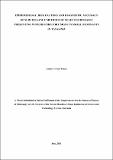| dc.description.abstract | Outbreaks of diseases presenting with respiratory signs in small ruminants in Tanzania have
been reported for years. Concurrent infections complicate diagnosis resulting in untimely
interventions and significant economic losses. A cross-sectional survey was conducted
between June, 2016 and July, 2017 to determine the risk factors associated with small
ruminants exposure to Mycoplasma capricolum subsp. capripneumoniae (M.
capripneumoniae) and small ruminant morbillivirus (SRMV). Outbreak investigations were
conducted between June, 2016 and July, 2018 to validate the performance of the existing and
improved disease surveillance systems and to evaluate the accuracy of the reports, the data
were also used to determine the level of concurrent infections in those outbreaks. Risk factors
data were analysed using logistic regression models. The field data forms (FD-1 and FD-2)
performance were analysed using inter-rater reliability test against the gold standard test. The
percentage proportions were used to describe levels of concurrent infections. Risk factors for
M. capripneumoniae occurrence in goats were farming system (OR = 0.91073332), mixing
species (OR= 1.0793679) and grazing with wild animals (OR=1.0546803). Occurrence of
SRMV in goats was influenced by farming system (OR=1.154254), mixing of flocks
(OR=1.060278) and grazing with wild animals (OR=1.077164). Risk factors for occurrence
of M. capripneumoniae in sheep were farming system (OR=0.9310771) and presence of PPR
(OR=1.0564274) whereas, SRMV was influenced by farming system (OR=1.188681),
mixing flocks (OR=1.135146) and previous diseases outbreak (OR=1.161883). In outbreak
investigations, FD-2 performed better than FD-1 in the diagnosis of both CCPP (PPV =
22.2% Vs 16.2%) and PPR (PPV = 50.0% Vs 43.2%) in goats and in sheep, in the diagnosis
of PPR (PPV = 26.3% Vs 23.1%). In determining concurrent infections, 79.1% (117/148) of
the goats and 28.1% (16/57) of the sheep had concurrent infections. The SRMV and
Pasteurella multocida (P. multocida) in goats and SRMV in sheep were the pathogens
involved in co-infections. This study reports several risk factors being associated with
exposure of small ruminants to M. capripneumoniae and SRMV and that, the current disease
surveillance system does not provide reliable accurate data on outbreaks with co-infections in
which P. multocida are involved and should be considered in control strategies. | en_US |

